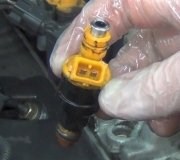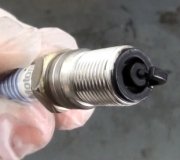Check the fuel pressure it should be 36 psi. Make sure your grounds that you tightened are clean as well as tight. Also there should be a good ground to body and engine. If you can spray choke cleaner in engine then it's probably a fuel problemif not it's ignition. Check primary coil resistance it should.9-1.1 ohms. If you dont' know how to do it, it is listed under repair on the site here. Injector resistance is 2.4 ohms at room temp. Also check for auxillary air valve malfunctionalso check the map sensor or if it has a vacuum line going to it check that for beign soft andcollapsing.
FUEL┬ CONTROL
CAUTION: This┬ test┬ results┬ in┬ fuel┬ vapor┬ being┬ present┬ in┬ engine┬ compartment.┬ All┬ necessary┬ precautions┬ against┬ fire┬ or┬ explosion┬ should┬ be┬ taken.
XJS┬ Cold┬ Start┬ System┬ Test
Remove┬ 2┬ set┬ screws┬ and┬ washers┬ retaining┬ cold┬ start┬ injectors┬ in┬ intake┬ manifold.┬ Remove┬ the┬ start┬ injectors┬ and┬ place┬ them┬ in┬ a┬ container┬ to┬ collect┬ sprayed┬ fuel.┬ Disconnect┬ distributor┬ lead┬ from┬ the┬ coil.
Engine┬ Temperature┬ Below┬ 59┬░F┬ (15┬░C)
1. Turn┬ ignition┬ on┬ and┬ check┬ the┬ cold┬ start┬ injectors┬ for┬ any┬ leakage.┬ Crank┬ the┬ engine┬ for┬ a┬ few┬ revolutions.┬ Injectors┬ should┬ spray┬ while┬ engine┬ cranks. DO┬ NOT┬ operate┬ starter┬ any┬ longer┬ than┬ necessary.
2. If┬ injectors┬ do┬ not┬ spray, ┬ crank┬ engine┬ and┬ check┬ for┬ battery┬ voltage┬ at┬ cold┬ start┬ injector┬ supply┬ (White/Pink)┬ cable.┬ If┬ voltage┬ is┬ present, ┬ check┬ ground┬ connections┬ and┬ wiring┬ harness┬ connectors┬ at┬ cold┬ start
injectors.┬ Repair┬ as┬ necessary.┬ If┬ no┬ defects┬ are┬ found, ┬ injectors┬ are┬ faulty┬ and┬ must┬ be┬ replaced.
3. Crank┬ engine┬ and┬ check┬ for┬ battery┬ voltage┬ at┬ terminal┬ No.┬ 87┬ of┬ cold┬ start┬ relay.┬ If┬ voltage┬ is┬ present, ┬ check┬ wiring┬ harness┬ between┬ relay┬ and┬ cold┬ start┬ injectors┬ and┬ repair┬ as┬ necessary.
4. Crank┬ engine┬ and┬ check┬ for┬ battery┬ voltage┬ at┬ terminal┬ No.┬ 30┬ of┬ cold┬ start┬ relay.┬ If┬ no┬ voltage┬ is┬ present, ┬ check┬ supply┬ wire┬ from┬ pump┬ relay┬ and┬ repair┬ as┬ necessary.┬ If┬ voltage┬ is┬ present, ┬ relay┬ is┬ not┬ being
energized┬ or┬ contacts┬ are┬ faulty.
5. Crank┬ engine┬ and┬ check┬ for┬ battery┬ voltage┬ at┬ terminal┬ No.┬ 86┬ of┬ cold┬ start┬ relay.┬ If┬ voltage┬ is┬ present, ┬ relay┬ is┬ not┬ being┬ energized┬ or┬ contacts┬ are┬ faulty.┬ If┬ no┬ voltage, ┬ repair┬ supply┬ wire┬ from┬ starter┬ circuit.
6. Crank┬ engine┬ and┬ check┬ for┬ battery┬ voltage┬ at┬ terminal┬ No.┬ 85┬ of┬ cold┬ start┬ relay.┬ If┬ voltage┬ is┬ present┬ and┬ relay┬ is┬ not┬ energizing, ┬ there┬ is┬ a┬ problem┬ with┬ thermo┬ time┬ switch┬ circuit.┬ Disconnect┬ wiring┬ harness┬ from
terminal┬ No.┬ 85┬ and┬ jump┬ terminal┬ No.┬ 85┬ to┬ ground.┬ Relay┬ should┬ now┬ energize.┬ If┬ not, ┬ relay┬ is┬ faulty┬ and┬ must┬ be┬ replaced.
7. If┬ relay┬ energizes, ┬ check┬ for┬ battery┬ voltage┬ at┬ terminal┬ No.┬ 87┬ of┬ cold┬ start┬ relay.┬ If┬ no┬ voltage┬ is┬ present┬ at┬ terminal┬ No.┬ 87, ┬ the┬ contacts┬ of┬ relay┬ are┬ faulty┬ and┬ relay┬ must┬ be┬ replaced.┬ Reinstall┬ cold┬ start┬ injectors
and┬ all┬ cables┬ or┬ connectors.
Engine┬ Temperature┬ Above┬ 59┬░F┬ (15┬░C)
1. Crank┬ engine┬ and┬ check┬ voltage┬ at┬ terminal┬ No.┬ 87┬ of┬ cold┬ start┬ relay.┬ Voltage┬ should┬ be┬ 0┬ (zero)┬ volts.┬ If┬ battery┬ voltage┬ is┬ present, ┬ remove┬ wiring┬ harness┬ connector┬ from┬ terminal┬ No.┬ 85┬ of┬ the┬ cold┬ start┬ relay.
2. If┬ voltage┬ is┬ 0┬ (zero)┬ volts, ┬ the┬ thermo┬ time┬ switch┬ is┬ at┬ fault┬ and┬ must┬ be┬ replaced.┬ If┬ battery┬ voltage┬ is┬ still┬ present┬ at┬ terminal┬ No.┬ 87┬ after┬ disconnecting┬ terminal┬ No.┬ 85, ┬ replace┬ cold┬ start┬ relay.
3. If┬ cold┬ start┬ injectors┬ pass┬ fuel┬ when┬ no┬ voltage┬ is┬ present┬ at┬ terminal┬ 87, ┬ the┬ injectors┬ must┬ be┬ replaced.
Image (Click to make bigger)
Thursday, December 29th, 2011 AT 1:10 AM




